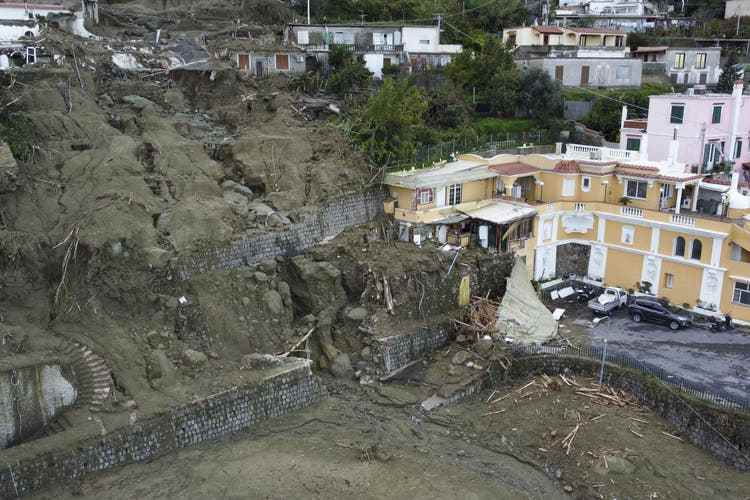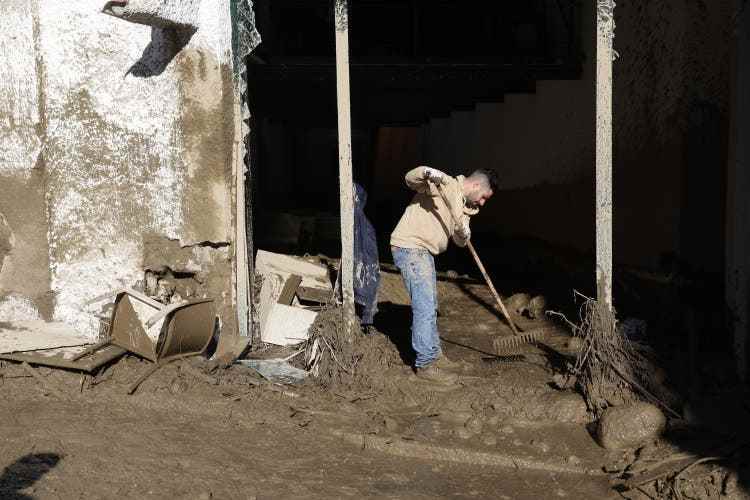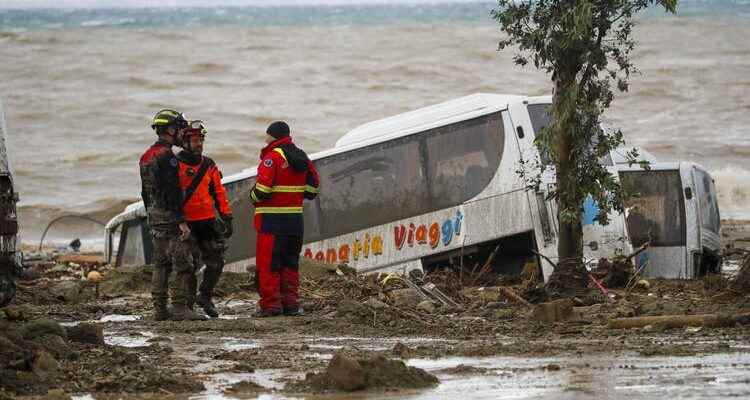Devastating earthquakes, now once again a severe storm with dead and injured: Casamicciola on the island of Ischia does not come to rest.
Rescue workers are on the island of Ischia by a bus that was swept away towards the sea by the mudslide.
After the severe storms in the night from Friday to Saturday, the Italian government closed the island of Ischia in the Gulf of Naples for a year on Sunday declared an emergency area. So far, seven deaths have been reported in the village of Casamicciola, which has been hit hard by heavy rains and mudslides – including a girl around five years old and a newborn. People are still missing. 130 people had to be evacuated from the danger zones.
While the rescue work is still in progress, the search for the causes of the storm has started. It follows a very Italian pattern: the dangers are known, but nobody is doing anything about them.
The steep flanks of the mighty Epomeo volcano have always been considered extremely fragile. Heavy rains like those of the last few days quickly have devastating effects, because the volcanic soil is not very compact and swells in heavy rain, as Micla Pennetta, professor of geomorphology in Naples, in the “Corriere della Sera” explained. There are mudslides.
Illegal buildings instead of trees
Trees would actually be a natural obstacle, but some of the trees on the Epomeo have fallen victim to the brisk, often illegal building activity of recent years. Construction takes place everywhere, even where the ground is unstable and there are special risks. “The cementation of the soil, in turn, has reduced the capacity of the water, which flows downwards with devastating force, carrying mud and other materials with it and causing disasters,” says Pennetta in the «Corriere». Terracing, reforestation, drainage canals and retention basins would help.
Hardly any of this is ever realized. There seems to be no cure for illegal building activity, neither in Ischia nor elsewhere in Italy. The local authorities often lack the courage to demolish the houses in question. And the builders always benefit from amnesty decrees of the government. The last was in 2018 by the Conte-Salvini government. According to environmentalists, almost 28,000 amnesty applications were received in Ischia afterwards.

Houses destroyed by the landslide on the island of Ischia.
For Casamicciola it is the umpteenth tragedy. For many tourists, the community of 8000 souls is the gateway to Ischia and to their summer holidays. Ferries from Naples and Pozzuoli bring holidaymakers to the town’s small port, which has a pretty beach promenade with numerous cafes and restaurants.
Ischia has experienced a real tourism boom in recent years. Many Germans, Russians and more and more Americans succumb to the magic of the island with its numerous bays and clear water. Since ancient times, the thermal springs have also been a popular destination for those seeking relaxation.
Meanwhile, Casamicciola seems less enchanted than bewitched. In 1910, eleven people died here as a result of heavy falling rocks, in 2006 a mudslide wiped out a family of four, and in 2009 a fifteen-year-old schoolgirl was swept away by the floods and died. According to civil defense, between 2018 and 2021, 72 landslides were registered in the village alone.
Where Benedetto Croce’s family perished
But that’s not all: Casamicciola, like all of Ischia, the neighboring island of Procida and numerous towns on the nearby mainland near Pozzuoli, belongs to the Phlegraean Fields, a zone of around 150 square kilometers that is considered a super volcano. The earth is constantly in motion here, and there are always minor or major earthquakes. So in August 2017, when the earth shook in Ischia. But devastation only happened in Casamicciola: two women died, one was killed by fragments of a church, a second died under the rubble of her house.
The tragedy of the Croce family is well known. Benedetto Croce, one of Italy’s great liberal minds, an important philosopher and politician, lost his entire family in Casamicciola. When he was just seventeen years old, his parents and sister were killed in the great earthquake of 1883. Since those days, the expression “E na’ Casamicciola” has been synonymous in the Gulf of Naples and beyond as a synonym for fear and sudden destruction.

A resident of Casamicciola cleans up.
Moses holds
lzb. Heavy rainfall has not only fallen over Ischia in Italy in the last few days, but also over the northern Adriatic. Record levels were recorded in the Po Delta area and off Venice in the middle of last week. The causes were the heavy rain and the Scirocco blowing from the south at the same time, which pushed the water into the lagoons. The fact that there was no major devastation and the notorious “acqua alta” in Venice is due on the one hand to the quick reaction of the population, who dragged sandbags in good time, and on the other hand to the large flood barrier “Mose”, which passed its first major stress test. “Mose” stands for Modulo Experimentale Elettromeccanico and has occupied Italian politics for years due to allegations of corruption and mismanagement. Anyway, it seems to be working now.
